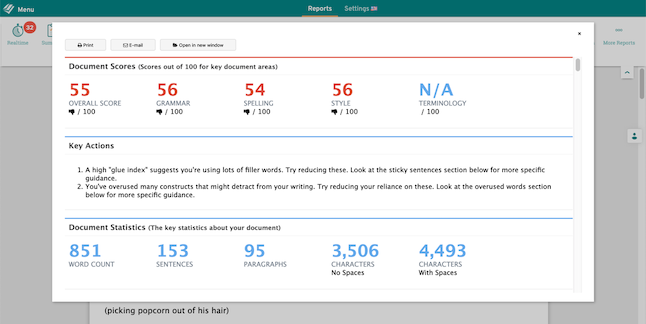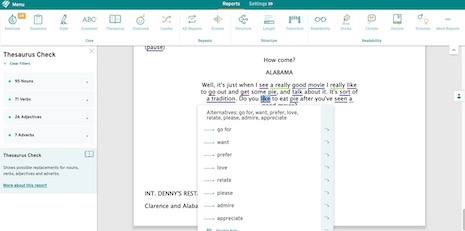
You’ve worked hard on your script. You’ve nailed your characters. Your plot sizzles. The Screenwriter’s Bible has been by your side every step of the way. And you are almost ready to pass out those thumb drives with your new baby.
The reality is you have to grab your reader’s attention out of that pile of scripts on their desk. Your language needs to sizzle to bring your script to life in the reader’s mind.
Before you send out your script, ProWritingAid can help you make some edits that will increase readability so a reader will zoom along without knowing why your script reads so well.
Why Clarity Matters In Your Writing
Clarity is important in video, perhaps more important than in text. While book readers can go back and reread a sentence, someone watching a video only has one chance to hear a sentence and understand its meaning.
The way you write your script will depend on your audience, overall message, and, of course, who or what is delivering the lines. That being said, there are a few clarity best practices all script writers should follow:
#1: Remove Glue Words
Glue words are the words that contain little information themselves, but they make the important parts of a sentence stick together: the, that, like, go, will, and, etc.
All sentences contain some glue words, but if you have lots, then it’s a sign that you should rewrite it to improve clarity. If you have too many glue words, your writing will be clunky.
#2: Make Passive Constructions Active
Passive voice means that you have written the object of your sentence first and then put the subject of your sentence at the end. Passive voice can be unclear because the subject is hidden at the end of the sentence (or sometimes, doesn’t appear at all).
Removing passive voice from video scripts is extra important because it’s much easier to follow a spoken sentence when the subject is presented first.
#3: Make Your Script Easier to Understand
An effective script doesn’t need to use fancy language; it needs to clearly communicate your meaning to your viewers. If the audience is thinking, “I have no idea what that phrase means,” then they’ll be distracted from the ideas you’re trying to convey.
It seems contradictory, but the best writing is often the simplest. The writing in your script should average at about a middle school level for your audience to get it.
Worried about making your script more clear? You needn't be! With ProWritingAid + Final Draft, you can easily make your writing more accessible to your actors and audience. Let's learn how.
Enter Your Script
To get started, upload your .fdx file to ProWritingAid.
The software immediately detects the script format and asks you if you want to use Script mode. Just answer "yes." This means it will recognize scene heading format and other script formatting instead of flagging them as as errors.
Twenty writing style reports can fine-tune your script to make it highly readable while avoiding clunky construction. Let’s look at the key reports that will enhance your script.
Nine Reports to Nail Your Screenplay
1. The Style Report
The style report gives you an overview of how your script reads. Run this first, then use individual reports to drill down on your writing.

Keep these scores in mind while you approach other reports. Also, remember that scriptwriting style differs from narrative prose. For example, the ratings for this script are for Quentin Tarantino’s True Romance, so don’t be too alarmed.
2. The Pronoun Report
Pronouns like he, she, and it are boring. Minimizing their use will keep readers reading and interested.
In any writing, it is a red flag for better writing. Try rephrasing your sentence.
Original:
OFFICER JONES slaps down a photo on the table.
JIM stares at it.
Rewrite:
OFFICER JONES slaps down a photo on the table.
JIM examines the fine features in the photo.
This change helps the reader visualize your scene, which is exactly what you need to keep them from tossing your script.
Avoid starting a sentence with a pronoun.
The software identifies all pronouns in your script. You decide.
3. The Consistency Check
This report helps identify any changes in spelling, like character names, throughout your script. You’ve spent a long time creating your script. Inadvertent changes like Marilee to Marrily will confuse readers. Like dotting Is and crossing Ts, you’ll keep everything clear.
Beyond spelling, the consistency report checks for hyphenation, capitalization, and punctuation.
4. The Repeats Check
Every writer has words they use repeatedly. The repeats check finds those words. Keep your script from being monotonous by identifying your much-used words and then use the Contextual Thesaurus to discover alternatives.
Using this check, you will come to learn words you use often and spot them while you are writing.
5. The Contextual Thesaurus
The contextual thesaurus allows you to explore a range of synonyms. Just double-click any word to substitute your new choice.
Unlike most thesaurus suggestions, this report offers replacement words that fit within the context of the sentence. So, if you use the same word more than once in your script, depending on the sentence context, the report will offer original suggestions. This makes it a brilliant tool to use along with the repeats check.

6. The Clichés and Redundancies Check
Keep your images fresh with imaginative metaphors. Time-worn clichés diminish the power of your script to grab attention. This report will spot image weakness and prompt you to use your imagination.
Redundancies are word pairs that can be served by one word, usually with an unnecessary modifier. Make your writing crisp by changing a phrase like frozen ice into ice. Your script reader will appreciate your tight writing.

Image courtesy of IMDB
7. The Diction Report
You want your writing to be clear and succinct in a script. The diction report identifies overblown phrases and suggests a simpler way to write. For example, change has the ability to to can.
You want to impress whoever is reading the script with your storyline and dialogue, not fancy language. You are creating a story that needs to be told in visual language. Language appropriate to a scholarly thesis is not welcome in a script. Every time you use complicated diction, you slow down the reader. They may not know the exact reason but will feel something is off.
The diction report keeps your script flowing and creates a highly readable story.
8. The Sticky Sentences Report
Sentence construction goes beyond diction and looks at the way a sentence flows. Good syntax makes good reading.
Sticky sentences are awkward, often long, usually overburdened, and hard to read. Remember in high school when the teacher marked "awkward" and you didn’t know what to do? Those are sticky sentences, and ProWritingAid not only finds them but makes suggestions for changes.
9. The Grammar Report
Last but not least, check your spelling and grammar right at the end by running this report. Think of it as like Microsoft Word's spellcheck, but with superpowers. Eliminate any embarrassing errors before submitting your script.
Improve Your Writing
As you continue your writing career, consistent use of ProWritingAid will prompt you to notice your personal writing weaknesses. You’ll correct as you write. You’ll shorten your editing time and continually improve your writing style.
Readability Gets Your Script Read
Every way you fine-tune your script is one step closer to getting it read and passed on to decision makers. Don’t let clumsy sentences, misused words, or inconsistencies keep your script from being read. ProWritingAid is like having a personal editor to help you strengthen your writing.


